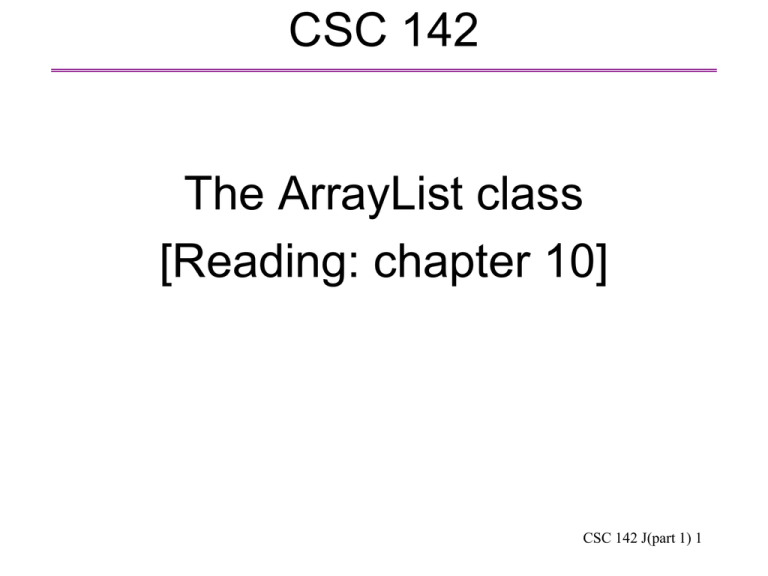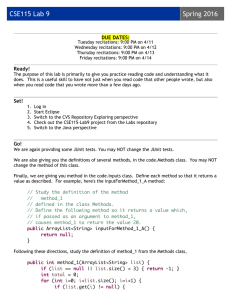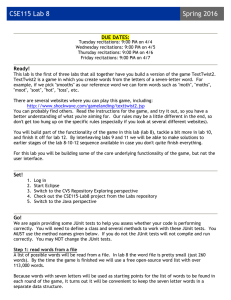powerpoint 10 (part 1)
advertisement

CSC 142
The ArrayList class
[Reading: chapter 10]
CSC 142 J(part 1) 1
The ArrayList class
Available in the package java.util.
An ArrayList object stores a list of items. The
ArrayList automatically manages its size. The
list grows as more items are added, or
shrinks as some items are removed.
Items stored in an ArrayList all have the same
reference type (i.e. defined by a class).
Primitive type values can’t be stored as such
in an ArrayList -> must use a wrapper type.
CSC 142 J(part 1) 2
Declaring an ArrayList object
A named collection of data items of the same
reference type.
To declare an ArrayList of Strings, write
ArrayList<String> phrases;
To declare an ArrayList of integers, write
ArrayList<Integer> numbers;
NOT ArrayList<int> numbers;
Always use the <> notation (= generics).
At this point, no memory is reserved for the
ArrayList
CSC 142 J(part 1) 3
Initializing an ArrayList
To initialize an ArrayList (once declared)
phrases = new ArrayList<String>();
numbers = new ArrayList<Integer>();
Other constructors are available e.g.
// Make a copy of an existing ArrayList
copy = new ArrayList<String>(phrases);
// Or if you know the size you need
daysOfTheWeek = new ArrayList<String>(7);
// But daysOfTheWeek is NOT limited
// to 7 elements
CSC 142 J(part 1) 4
Manipulating ArrayList elements (1)
To add an element to an ArrayList
ArrayList<String> a = new ArrayList<String>();
a.add(“Monday”);
a.add(“Wednesday”);
To access an ArrayList element, use its index
(also called subscript), e.g.,
String first = a.get(0); // Monday
String second = a.get(1); // Wednesday
Indices start at 0. If an ArrayList has 10 elements, the first
element has index 0 and the last element has index 9.
• To insert in an ArrayList
a.add(1,“Tuesday”);
//Wednesday is now at index 2
CSC 142 J(part 1) 5
Manipulating ArrayList elements (2)
To remove an element from an ArrayList
String s = a.remove(1); // element at index 1 is
// removed automatically, elements at indices > 1
// are shifted down
// Also:
boolean success = a.remove(s);
// removes s (= some object) if present. Returns true
// if s has been removed, and false if not.
Other operations:
indexOf, contains, set
See java documentation
CSC 142 J(part 1) 6
ArrayList and loops (1)
Loop with an index
e.g. if a is an ArrayList of Rectangle objects
for(int i = 0; i < a.size(); i ++) {
Rectangle r = a.get(i);
Number of elements
// work with r...
in a
}
Loop with an iterator
Iterator<Rectangle> it = a.iterator();
// could also use a ListIterator
while(it.hasNext()) {
Rectangle r = it.next();
// work with r...
CSC 142 J(part 1) 7
}
ArrayList and loops (2)
for each loop
for(Rectangle r : a) {
// work with r...
}
Which one to use?
To read the elements in no special order,
use a for each loop.
To iterate through the ArrayList in a special
way (e.g. from last to first, every other
element), use a loop with an index.
for each and iterator loops are read only.
CSC 142 J(part 1) 8
Memory view
ArrayList<String> a= new ArrayList<String>();
a.add(“Mercury”);
a.add(“Earth”);
a.add(1,”Venus”);
String
a
ArrayList
“Mercury”
String
0
1
2
“Venus”
String
“Earth”
CSC 142 J(part 1) 9


